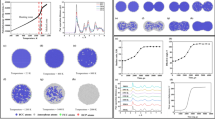Abstract
We present in this paper a numerical algorithm that couples the atomistic and continuum models for the thermal-mechanical coupled problem of polycrystalline aggregates. The key point is that the conservation laws should be satisfied for both the atomistic and continuum models at the microscale. Compared with the traditional methods which construct the constitutive equations of the grain interiors and grain boundaries by continuum mechanics, our model calculates the continuum fluxes through molecular dynamics simulations, provided that the atomistic simulations are consistent with the local microstate of the system. For the grain interiors without defects, central schemes are available for solving the conservation laws and the constitutive parameters can be obtained via molecular dynamics simulations. For the grain boundary structures, the front tracking method is employed because the solutions of the conservation equations are discontinuous near the defects. Firstly, appropriate control volumes are chosen at both sides of the interface, then the finite volume method is applied to solve the continuum equations in each control volume. Fluxes near both sides of the interface are calculated via atomistic simulations. Therefore, all thermo-mechanical information can be obtained.
Similar content being viewed by others
References
Chen Y, Cui J Z, Nie Y F, et al. The thermo-mechanics coupled model of polycrystalline aggregates based on plastic slip system in crystals and their interfaces. Adv Mater Res, 2011, 295-297: 397–405
Chen Y, Cui J Z, Nie Y F, et al. A new algorithm for the thermo-mechanical coupled frictional contact problem of polycrystalline aggregates based on plastic slip theory. Comput Modeling Eng Sci, 2011, 76: 189–206
Bronkhorst C A, Ross A R, Hansen B L, et al. Modeling and characterization of grain scale strain distribution in polycrystalline Tantalum. Comput Mater Continua, 2010, 17: 149–175
Lim T J, McDowell D L. Cyclic thermomechanical behavior of a polycrystalline pseudoelastic shape memory alloy. J Mech Phys Solid, 2002, 50: 651–676
Thamburaja P, Nikabdullah N. A coupled thermo-mechanical theory for polycrystalline SMAs. Smart Dev-Modeling Mater Syst, 2008, 1029: 27–49
Bloomfield M O, Bentz D N, Sukharev V, et al. Hybrid grain-continuum model for thermo-mechanical stresses in polycrystalline Cu 3D IC Vias. In: 2007 IEEE international Reliability Physics symposium proceedings — 45th Annual. Phoenix, AZ: IEEE, 2007. 644–645
Nae F A, Matsuzaki Y J, Ikeda T. Micromechanical modeling of polycrystalline shape-memory alloys including thermo-mechanical coupling. Smart Mater Struct, 2003, 12: 6–17
Chen S Q, E W, Shu C W. The heterogeneous multiscale method based on the discontinuous Galerkin method for hyperbolic and parabolic problems. Multiscale Model Simul, 2005, 3: 871–894
Weinan E, Ming P B, Zhang P W. Analysis of the heterogeneous multiscale method for elliptic homogenization problems. J Amer Math Soc, 2005, 18: 121–156
Ming P B, Zhang P W. Analysis of the heterogeneous multiscale method for parabolic homogenization problems. Math Comput, 2007, 76: 153–177
Li X T, E W. Multiscale modeling of the dynamics of solids at finite temperature. J Mech Phys Solids, 2005, 53: 1650–1685
Liu B, Qiu X M. How to compute the atomic stress objectively? J Comput Theor Nanosci, 2009, 6: 1081–1089
Liu B, Qiu X M. Investigation on the applicability of various stress definitions in atomistic simulation. Acta Mech Sin, 2009, 22: 644–649
LeVeque R J. Numerical Methods for Conservation Laws. Basel: Birkhäuser Verlag, 1992
Godlewski E, Raviart P A. Numerical Approximation of Hyperbolic Systems of Conservation Laws. New York: Springer, 1996
Nessyahu H, Tadmor E. Non-oscillatory Central Differencing for Hyperbolic Conservation Laws. J Comput Phys, 1990, 87: 408–463
Glimm J, Li X L, Liu Y J, et al. Conservative Front Tracking with Improved Accuracy. Siam J Numer Anal, 2003, 41: 1926–1947
Liu J J, Lim H K, Glimm J, et al. A conservative front tracking method in N-Dimensions. J Sci Comput, 2007, 31: 213–236
Wang Z Q, Zhao Y P. Thermo-hyperelastic models for nanostructured materials. Sci China-Phys Mech Astron, 2011, 54: 948–956
Xiang M Z, Cui J Z, Li B W, et al. Atom-continuum coupled model for thermo-mechanical behavior of materials in micro-nano scales. Sci China-Phys Mech Astron, 2011, 55: 1125–1137
Author information
Authors and Affiliations
Corresponding author
Rights and permissions
About this article
Cite this article
Tian, X., Cui, J. & Li, B. A new method for modeling thermo-mechanical behaviors of polycrystalline aggregates. Sci. China Phys. Mech. Astron. 55, 2143–2151 (2012). https://doi.org/10.1007/s11433-012-4899-y
Received:
Accepted:
Published:
Issue Date:
DOI: https://doi.org/10.1007/s11433-012-4899-y




